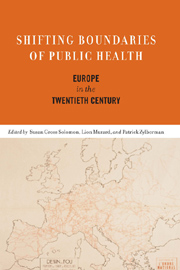Book contents
- Frontmatter
- Contents
- Preface
- Introduction
- Part One Place as Politics
- Part Two Carving Out the International
- Part Three Preserving the Local
- 6 Designs within Disorder: International Conferences on Rural Health Care and the Art of the Local, 1931–39
- 7 Contested Spaces: Models of Public Health in Occupied Germany
- 8 British Public Health and the Problem of Local Demographic Structure
- Part Four Navigating between International and Local
- Selected Bibliography
- List of Contributors
- Index
6 - Designs within Disorder: International Conferences on Rural Health Care and the Art of the Local, 1931–39
from Part Three - Preserving the Local
Published online by Cambridge University Press: 12 September 2012
- Frontmatter
- Contents
- Preface
- Introduction
- Part One Place as Politics
- Part Two Carving Out the International
- Part Three Preserving the Local
- 6 Designs within Disorder: International Conferences on Rural Health Care and the Art of the Local, 1931–39
- 7 Contested Spaces: Models of Public Health in Occupied Germany
- 8 British Public Health and the Problem of Local Demographic Structure
- Part Four Navigating between International and Local
- Selected Bibliography
- List of Contributors
- Index
Summary
“Public health, like government, must be ‘of all the people’ and ‘by all the people,’ as well as ‘for all the people.’” This statement by C. E. A. Winslow, professor emeritus of public health at Yale University, to the Fifth World Health Assembly in 1952, outlines a grassroots, developmentalist program of public health that he hoped would not be “sold as a finished product of expert thinking” but would instead be “planned to meet the needs of a particular locale.”
A legacy of the League of Nations Health Organization (LNHO), Winslow's call included three essential components: (1) the equation of public health with social improvement; (2) a move away from top-down, large-scale crash programs offered by outsiders; and (3) a deep sensitivity to the peculiarities of local, “vernacular” cultures. As early as 1936, the elite among transnational experts were claiming that “the best health program is to raise the standard of living of the people.” In arguing for the importance of avoiding community health organization “imposed by fiat from on high,” Winslow was mirroring their reservations about the “standard” solutions and other prepackaged projects that American philanthropy deployed between the wars to almost every European locale. Andrija Štampar, Bela Johan, Ludwik Rajchman, Frank G. Boudreau, Edgar Sydenstricker and John A. Kingsbury as well as Selskar M. Gunn, Jacques Parisot, René Sand, John B. Grant, and Berislav Borcic: all of these tough-, like-minded professionals had been won over to the principle of a locally democratic path to root-and-branch reform.
- Type
- Chapter
- Information
- Shifting Boundaries of Public HealthEurope in the Twentieth Century, pp. 141 - 174Publisher: Boydell & BrewerPrint publication year: 2008



